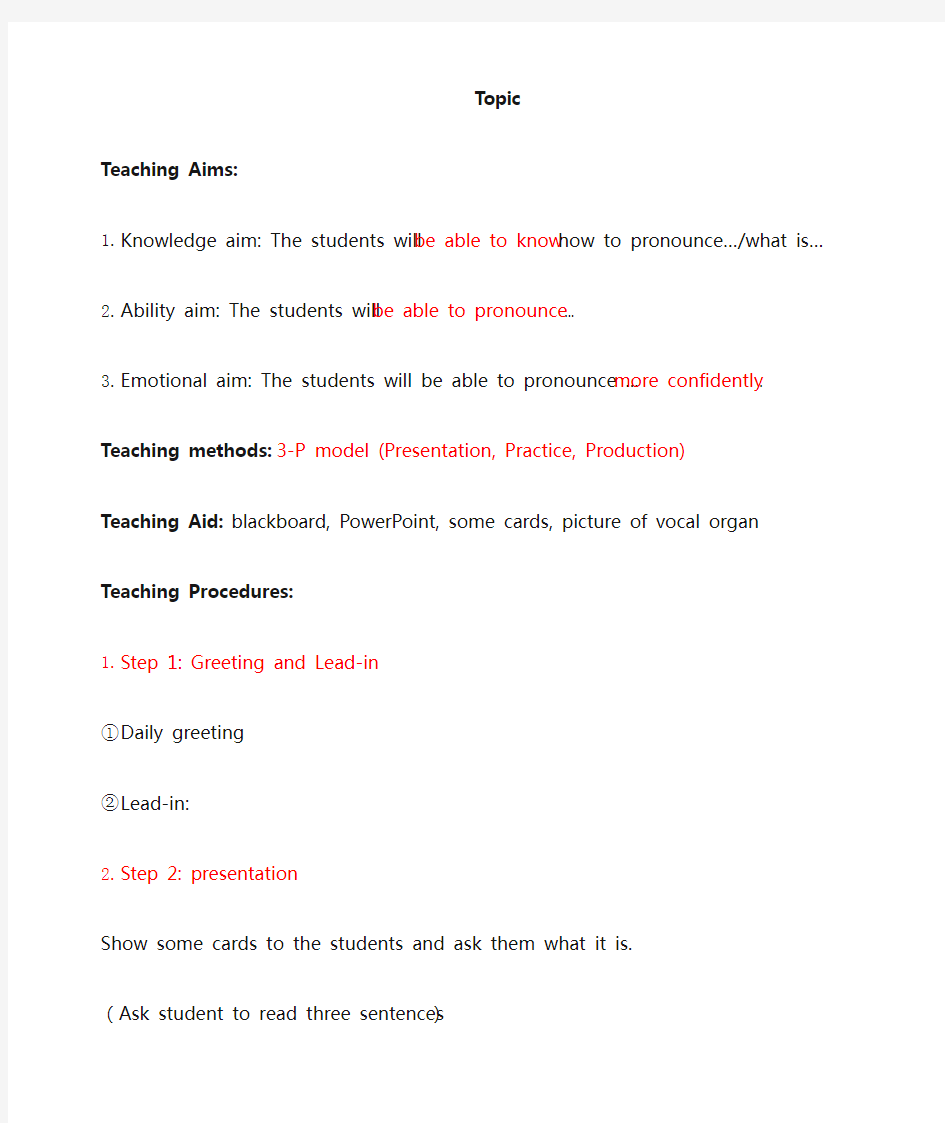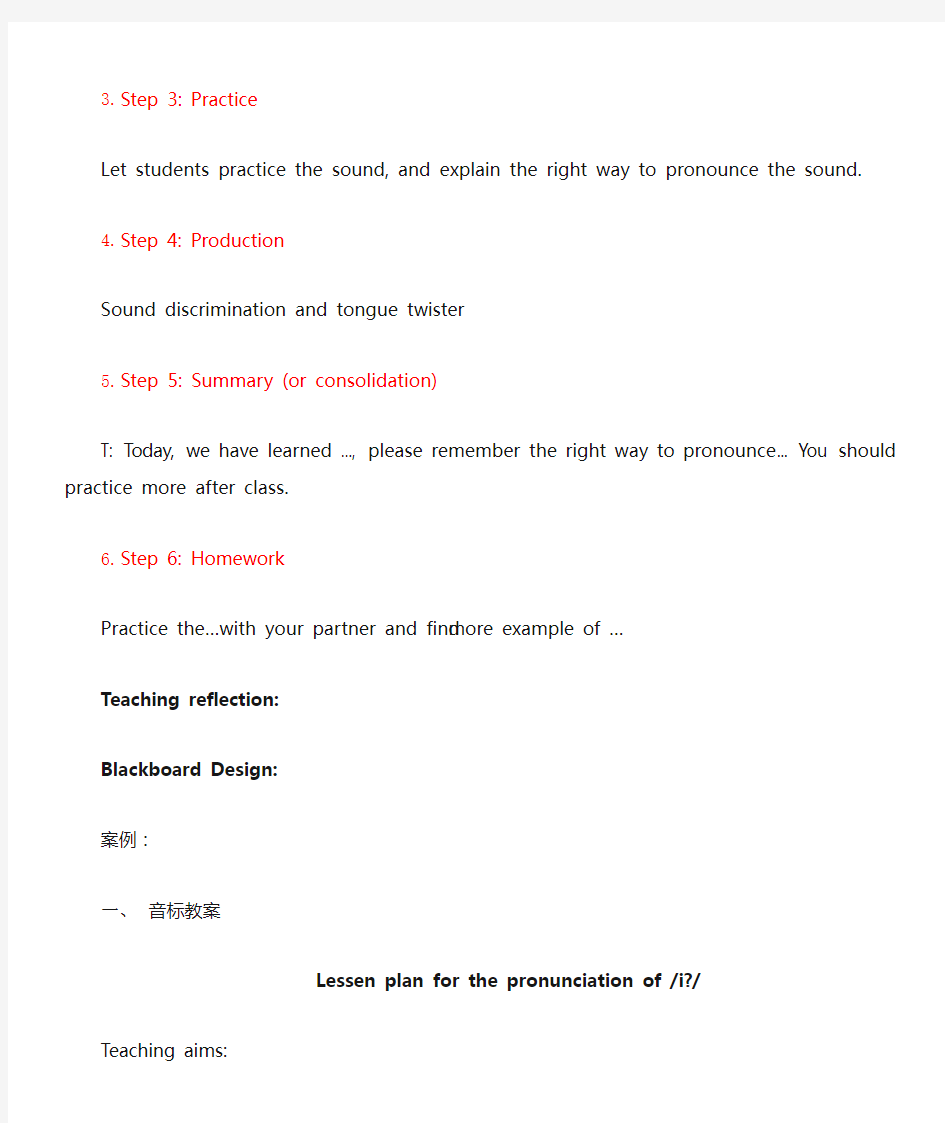

Topic
Teaching Aims:
1.Knowledge aim: The students will be able to know how to pronounce…/what is…
2.Ability aim: The students will be able to pronounce ...
3.Emotional aim: The students will be able to pronounce ... more confidently. Teaching methods:3-P model (Presentation, Practice, Production)
Teaching Aid: blackboard, PowerPoint, some cards, picture of vocal organ Teaching Procedures:
1.Step 1: Greeting and Lead-in
①Daily greeting
②Lead-in:
2.Step 2: presentation
Show some cards to the students and ask them what it is.
(Ask student to read three sentences)
3.Step 3: Practice
Let students practice the sound, and explain the right way to pronounce the sound.
4.Step 4: Production
Sound discrimination and tongue twister
5.Step 5: Summary (or consolidation)
T: Today, we have learned …, please remember the right way to pronounce... You should practice more after class.
6.Step 6: Homework
Practice the…with your partner and find more example of …
Teaching reflection:
Blackboard Design:
案例:
一、音标教案
Lessen plan for the pronunciation of /i?/
Teaching aims:
(1)Knowledge aim: be able to know how to pronounce the diphthong /i?/
(2)Ability aim: By the end of the class, students should be able to pronounce the diphthong/i?/
(3)Emotional aim: be able to pronounce the /i?/more confidently
Teaching methods: 3-P model(Presentation, Practice, Production)
Teaching aids: chock, blackboard, some cards
Teaching procedure:
1)StepⅠGreeting and Lead-in
2)StepⅡ Presentation
Show some cards to the students. Lead in the diphthong /i?/
3)StepⅢ Practice
explain the right way to pronounce the sound and practice the students the sound /i?/.
4)StepⅣ Production
Sound discrimination and tongue twister
StepⅤ Summarize
StepⅥ Homework
Practice the diphthong /i?/ with your partner.
稿子:
Class begins. Good morning/afternoon, boys and girls. Nice to have this English class with you. Today we are going to learn a diphthong in English.
T: first,I will show some cards. Do you know, what is this in English
T: yes, very good. This is a deer. Now read after me, deer.
T: deer
T: OK, very good. Then the second one, what is this in English
T: good. This is a girl. And what is she doing now
T: Yes, she is crying, so in her eyes, there is …
T: excellent! There are tears in her eyes. Read after me. Tear
T: tear
T: Ok. Now, another picture, what is this in English
T: you are great. This is a bottle of beer. Now read after me, beer
T: beer
T: Ok. We have learned these three words: deer, tear and beer. From these words, can you find something in common
T: yes, very good. These words all contain the sound/i?/. Now read after me, /i?/ /
T: /i?/
T: /i?/
T: Now, do you know the right way to pronounce the diphthong /i?/
T: this is a diphthong. It begins with the first sound /i/,( write the /i/ on the blackboard) and glide towards the second sound /?/,( write the /?/ on the blackboard) remember
T: Ok, very good. Now who can pronounce the sound Aslan, you, please
T: /i?/, read after me.
T: yes, very good. Lily, can you
T: OK Good. Candy, please
T: yes, very good.
T: Ellen, how about you
T: Good. But you should change the shape of your mouth as you move from one sound
to another. Now, look at the position of my lips when I pronounce this sound. /i?/, /i?/, /i?/. Now read after me, /i?/
T: OK, excellent. Now, the whole class read after me. /i?/
T: /i?/
T: /i?/.
T: /i?/.
T: very good. Now, I will divide you into two groups. Group 1 read the sound three times, and then group 2. Do I make myself clear
S: Yes.
T: /i?/. One two go.
T: very good. Now group2
T: good. You all have done a good job. Now le t’s do some exercise of sound discrimination. Listen to me carefully and circle the words which contain the sound /i?/ from each of the following pairs. , peer pear
T: excellent. , tare tear
T: are you sure
T: OK, very good. dare
T: great! mere mare
T: you are so smart. Now, please look at the blackboard. There is a tongue twister. Who can read it out Miky, you, please.
T: very good. A deer and a mare spare mere one second to drink a bottle of beer without tears. And who would like to try cuqi, please.
T: excellent!
T: today, we have learned the sound /i?/; remember the right way to pronounce this sound. It begins with the first sound /i/ and glide towards the second sound /?/, you should practice more after class. Your homework is to practice the diphthong /i?/ with your partner. OK. That's all for today's class. See you!
Topic
Teaching Aims:
1.Knowledge aim: The students will be able to know how to pronounce…/what is…
2.Ability aim: The students will be able to pronounce ...correctly
3.Emotional aim: The students will be able to speak English more confidently. Teaching methods:3-P model (Presentation, Practice, Production)
Teaching Aid: blackboard, PowerPoint, some cards,
Teaching Procedures:
1.Step 1: Greeting and Lead-in
①Daily greeting
②Lead-in: play a video and ask the students to pay attention to the
pronunciation of native speakers. Then, ask some question about the video: What are they talking about Do you notice how they pronounce … …
2.Step 2: presentation
Read the text and ask students to underline the parts where the pronunciation phenomenon is similar with the one shown in the video.
Ask students to conclude the common point of those parts.
Based on what students say, explain the pronunciation phenomenon
3.Step 3: Practice
Ask students to read the text again.
Ask students to read the examples on PPT.
4.Step 4: Production
Sound discrimination and tongue twister
Ask students to discuss… with their partners.
5.Step 5: Summary
Briefly summarize the skill to pronounce …
6.Step 6: Homework
Practice the…with your partner and find more example of …
Teaching reflection:
Blackboard Design:
语音教学试讲真题
内容
But she began to trust him, she told him how she was overweight and this made her feel unhappy .also she felt her home wasn’t elegant enough for someone like larry who wanted to improve his social position
基本要求
针对段落长句设计示范连读重读的教学步骤